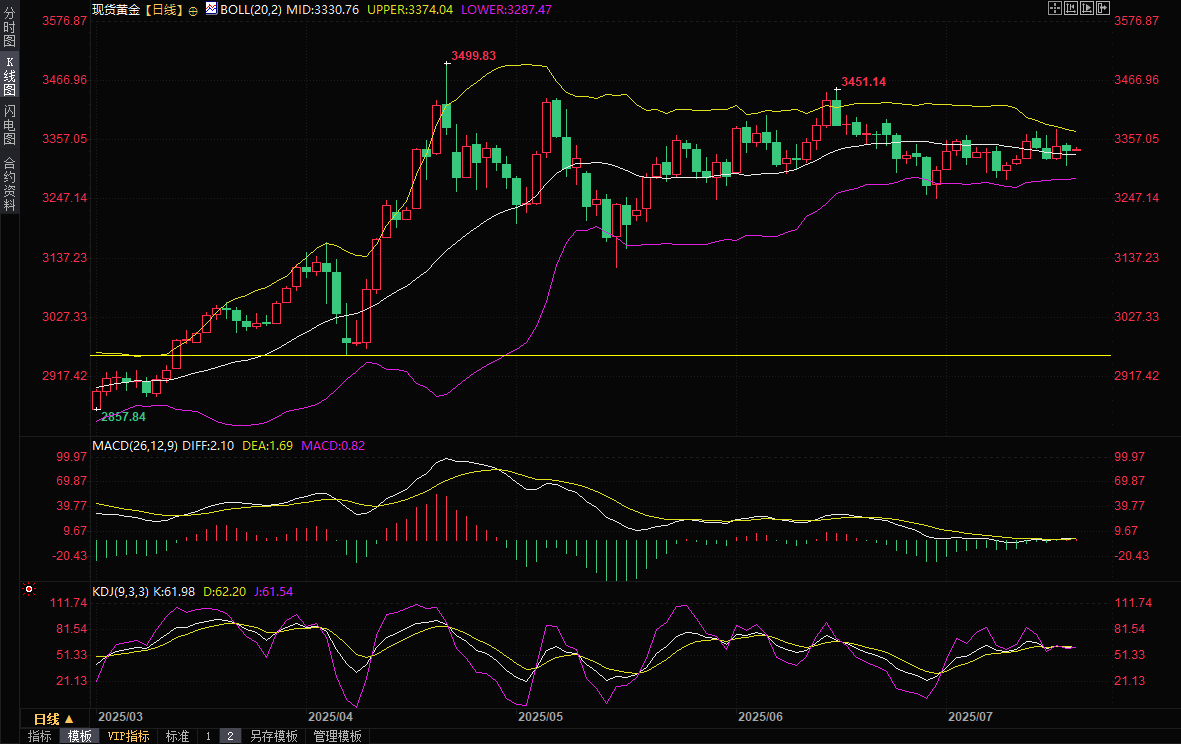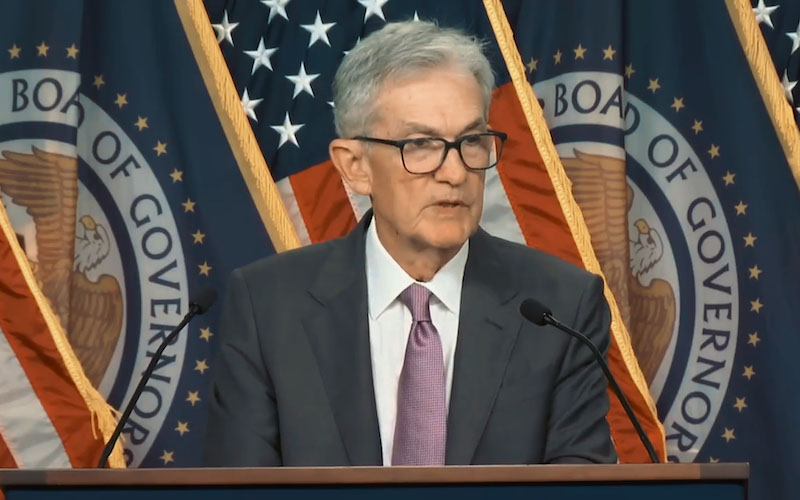Gold trading reminder: Gold prices staged a "Jedi counterattack", pay attention to the Fed's interest rate cut expectations and trade situation
2025-07-18 07:36:43
Bob Haberkorn, strategist at RJO Futures, made a particularly insightful observation: "The rise in the dollar and U.S. Treasury yields has indeed suppressed gold prices, but strong takeover orders have emerged in every window of decline." Behind this phenomenon, smart money is quietly making arrangements. When the 10-year U.S. Treasury yield climbed to a monthly high of 4.495%, gold refused to fall further. This divergence suggests that the market has serious differences on the direction of the Fed's policy.

US economic data: strong retail sales and employment, bearish for gold in the short term
The strong performance of US economic data has provided support for the Fed to postpone its interest rate cuts and has also put short-term pressure on gold prices. June retail sales data exceeded expectations, increasing by 0.6%, and core retail sales (excluding automobiles, gasoline, building materials and food services) increased by 0.5%, indicating a modest recovery in consumer spending in the second quarter. Tom Simons, chief US economist at Jefferies, pointed out that despite the weak consumer confidence index, consumers did not reduce spending due to tariff announcements or market fluctuations, but instead bought big-ticket items with an "opportunistic" mentality. This consumer resilience shows that the fundamentals of the US economy remain solid, further reducing the need for the Fed to cut interest rates immediately.
At the same time, labor market data also performed strongly. The U.S. Department of Labor reported that the number of initial unemployment claims fell by 7,000 to 221,000 in the week ending July 12, the lowest level in three months, lower than the market expectation of 235,000. The number of continuing unemployment claims increased slightly to 1.956 million, but was still at a historical low overall, indicating that the stability of the labor market supported consumer spending.
JPMorgan economist Abiel Reinhart said the unemployment claims data reflected steady growth in the labor market, in line with the trend of the past few years. However, slowing wage growth, falling house prices and trade policy uncertainty could weaken future consumer spending, and these potential risks provide long-term support for gold.
The Fed's "hawk-dove war" is heating up, and expectations for rate cuts are in a fog
A rare policy dispute is taking place within the Federal Reserve. The tough stance of Board member Kugler is like a "hawkish punch". She clearly warned: "When tariffs begin to push up consumer prices, we must maintain restrictive policies to curb inflation expectations." This remark directly points to the chain reaction of the Trump administration's tariffs on China - the prices of tariff-sensitive goods such as household goods and electrical appliances have risen significantly in June.
However, San Francisco Fed President Mary Daly has launched a "dovish combination punch". She insisted that it is still reasonable to cut interest rates twice before the end of the year, and stressed: "The actual impact of tariffs is milder than expected, and we should not over-tighten to hurt the job market." Even more striking is that Director Waller suddenly put forward the shocking view that "interest rates should be cut by 25 basis points in July". The three reasons he put forward are extremely lethal: tariff inflation is temporary, economic growth is already below potential levels, and the job market is fraught with risks. This split in high-level opinions has led to violent fluctuations in the interest rate futures market. Current pricing shows that the probability of a rate cut in September remains at 54%, but the possibility of action in July has risen to 30%.
US dollar and US bond yields: strong rebound exacerbates gold price volatility
The trend of the US dollar and US Treasury yields is crucial to the short-term performance of gold prices. On Thursday, the US dollar index rose 0.36% and hit 98.95 during the session, the highest level since June 23. Marc Chandler, chief market strategist at Bannockburn Global Forex, believes that the rebound of the US dollar is mainly due to the rise in US Treasury yields and short covering. The 10-year US Treasury yield was 4.459%, up 23.1 basis points this month, and the 30-year US Treasury yield climbed to 5.009%. Vishal Khanduja, head of fixed income at Morgan Stanley Investment Management, pointed out that strong economic data pushed up yields, rather than the market's concerns about economic weakness, which further supported the strength of the US dollar.
The stronger dollar makes dollar-denominated gold more expensive for investors holding other currencies, which directly puts pressure on gold prices. Spot gold fell to $3,309.82 per ounce after the data was released, but then supported by bargain hunting and closed at $3,338.86 per ounce, narrowing the decline to 0.25%. Bob Haberkorn, senior market strategist at RJO Futures, said the rise in the dollar and U.S. Treasury yields was the main reason for the weakness in the gold market. However, the dollar index is still down 9% this year, indicating that its long-term trend may provide some support for gold.
Tariff policy: Surrounded by uncertainty, gold's safe-haven function stands out
The Trump administration's tariff policy is the focus of current market attention. Japan is in emergency negotiations with the US Secretary of Commerce to avoid a 25% tariff. If no agreement is reached before August 1, the tariff will officially take effect. According to a Reuters report, import prices rose by only 0.1% month-on-month in June, lower than the expected 0.3%, but import prices from China, Japan and the European Union rose strongly, indicating that foreign exporters have not fully absorbed the tariff costs. Sarah House, senior economist at Wells Fargo, pointed out that the increase in import prices shows the direct impact of tariffs on prices, which may further push up inflation expectations.
Uncertainty about tariff policies supports the safe-haven function of gold. Although gold prices are suppressed by the dollar and rising yields in the short term, the intensification of trade tensions may trigger a rise in risk aversion in the market, driving a rebound in gold prices. In addition, Trump's pressure on Federal Reserve Chairman Powell and potential disputes over monetary policy independence have also injected uncertainty into the gold market. Former Federal Reserve Governor Warsh suggested that the agreement between the Federal Reserve and the Treasury Department needs to be reviewed, which may further shake the market's confidence in the independence of the Federal Reserve, thereby increasing the attractiveness of gold.
Future Outlook: Gold prices are looking for direction amid multiple factors
Overall, the gold market is currently in a multi-game of Fed policy, US economic data, US dollar trends and tariff policies. The Fed's stance on postponing rate cuts, strong retail and employment data, and rising US dollar and US bond yields have suppressed gold prices in the short term. However, the support of bargain hunting shows the market's long-term confidence in gold. The uncertainty of tariff policies and potential inflationary pressures may further enhance gold's safe-haven appeal, while the disagreement within the Fed on the timing of rate cuts has also added variables to the trend of gold prices.
On this trading day, we need to pay attention to the preliminary value of the University of Michigan Consumer Confidence Index in July and the U.S. real estate market data, pay attention to the G20 Finance Ministers and Central Bank Governors Meeting hosted by South Africa, and pay attention to news related to the international trade situation.

(Spot gold daily chart, source: Yihuitong)
At 07:33 Beijing time, spot gold was trading at $3,342.59 per ounce.
- Risk Warning and Disclaimer
- The market involves risk, and trading may not be suitable for all investors. This article is for reference only and does not constitute personal investment advice, nor does it take into account certain users’ specific investment objectives, financial situation, or other needs. Any investment decisions made based on this information are at your own risk.










